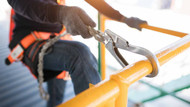Working at heights presents numerous hazards that can lead to severe injuries or even fatalities if not properly addressed. These risks are not limited to construction sites; they can be found in a wide variety of workplaces, from warehouses to factories, agricultural settings, and even during the maintenance and repair of machinery.
In these situations, workers risk falling from the machinery or the elevated work surfaces, potentially resulting in serious injuries or fatalities. In addition, workers may also be exposed to other hazards, such as moving parts, high voltages, or hazardous materials, which can further increase the risks associated with working at heights.
Another scenario that may require working at heights is during routine maintenance or installation tasks in warehouses, factories, or other industrial settings. Workers may need to access high storage racks, install or repair overhead lighting, or perform maintenance on overhead cranes or other equipment.
These tasks often involve ladders, elevated work platforms, or other height access equipment and can expose workers to the risk of falls or being struck by falling objects. Inadequate training, improper use of equipment, or lack of appropriate fall protection can significantly increase the likelihood of accidents occurring in these situations.
Understanding the dangers of working at heights is crucial for employers and employees. According to Safe Work Australia, falls from heights account for a significant percentage of work-related injuries and fatalities. At SafetyDocs, our mission is to promote workplace safety, especially when working at heights.
In this guide, we will explore the three core components of our safety plan: the Height Access Equipment Safe Work Method Statement, the Falls Emergency Rescue Plan, and the Falls Prevention & Falling Objects Management Plan.
Height Access Equipment Safe Work Method Statement
SafetyDocs' Height Access Equipment Safe Work Method Statement, is a crucial first step in safeguarding workers against falls from heights. This detailed document outlines workers' procedures when working at elevated levels. It covers essential aspects such as:
Identifying and assessing potential hazards: Workers should be trained to recognise hazards related to working at heights, including unstable surfaces, unprotected edges, and adverse weather conditions.
Selecting and inspecting equipment: This includes choosing the appropriate height access equipment, such as ladders, scaffolding, or elevated work platforms, and ensuring they are in good working condition.
Using safety equipment: Workers must be equipped with and know how to use personal protective equipment, such as harnesses, lanyards, and anchorage points.
Setting up fall protection systems: When working at heights, it is crucial to have a reliable fall protection system, such as guardrails, safety nets, or fall arrest systems.
Falls Emergency Rescue Plan
Despite taking all necessary precautions, falls can still occur. In such cases, it is vital to have a well-defined Falls Emergency Rescue Plan in place. This plan should include:
Designating emergency response personnel: These individuals should be trained in first aid and rescue procedures and be familiar with the rescue equipment.
Establishing communication protocols: This includes notifying the proper authorities and having a system for communicating with the fallen worker during the rescue operation.
Identifying the nearest emergency exit: Workers should know the closest exit routes and muster points.
Conducting regular rescue drills: Regular practice will ensure that all workers are familiar with the rescue procedures and can respond effectively in an emergency.
Falls Prevention & Falling Objects Management Plan
Preventing falls and falling objects is the most effective way to ensure worker safety when working at heights. SafetyDocs' Falls Prevention & Falling Objects Management Plan outlines specific measures that need to be taken to prevent falls and falling objects, such as:
Implementing fall protection systems: Depending on the specific work environment and tasks, fall protection systems like guardrails, safety nets, or fall arrest systems should be installed and maintained.
Ensuring proper housekeeping: Keeping work areas clean and debris-free can prevent tripping hazards and reduce the risk of falling objects.
Training and supervision: Regular training sessions and close supervision can help workers stay aware of potential hazards and reinforce safe work practices.
Encouraging a safety culture: Encourage workers to report unsafe conditions and near misses and acknowledge their contributions to maintaining a safe workplace.
At SafetyDocs, we are committed to helping you prioritise workplace safety and maintain compliance with relevant regulations. To learn more about our Height Access Equipment Safe Work Method Statement, Falls Emergency Rescue Plan, and Falls Prevention & Falling Objects Management Plan, visit our product pages or contact our knowledgeable sales team.
Together, we can create a safer work environment for everyone involved and significantly reduce the risks associated with working at heights. Employers and employees can work together to ensure a safe working environment by recognising potential hazards and implementing appropriate safety measures.
Our team of experts is dedicated to providing accurate and informative content.
Author - Craig Cruickshank is the HSEQ Manager and Senior Technical Advisor at SafetyDocs by SafetyCulture.
Craig comes from a construction and environmental background, with experience in both the private and public sectors and is passionate about making health and safety information easy to find and understand for everyone.
Learn more about Craig's work on LinkedIn
Available for instant download and supplied in fully editable MS Word format for use in your business.
Please note that the above information is provided as a comment only and should not be relied on as professional, legal or financial advice.
Share This Article
